This post may contain affiliate links. Please read our disclosure policy.
Are you ready to make the best gluten free stuffing recipe you've ever tasted? A delicious turkey stuffing (or dressing) is an essential staple for any gathering, adding flavor and texture to the whole meal.
This particular recipe is a game-changer for anyone seeking the ultimate gluten free Thanksgiving stuffing. It’s so delicious and satisfying that even your non-gluten-free guests and family will ask for seconds! It even travels well, something I know well since I've been making an entirely safe gluten free meal for my celiac son and taking it on the road for the holidays since he was a little boy!
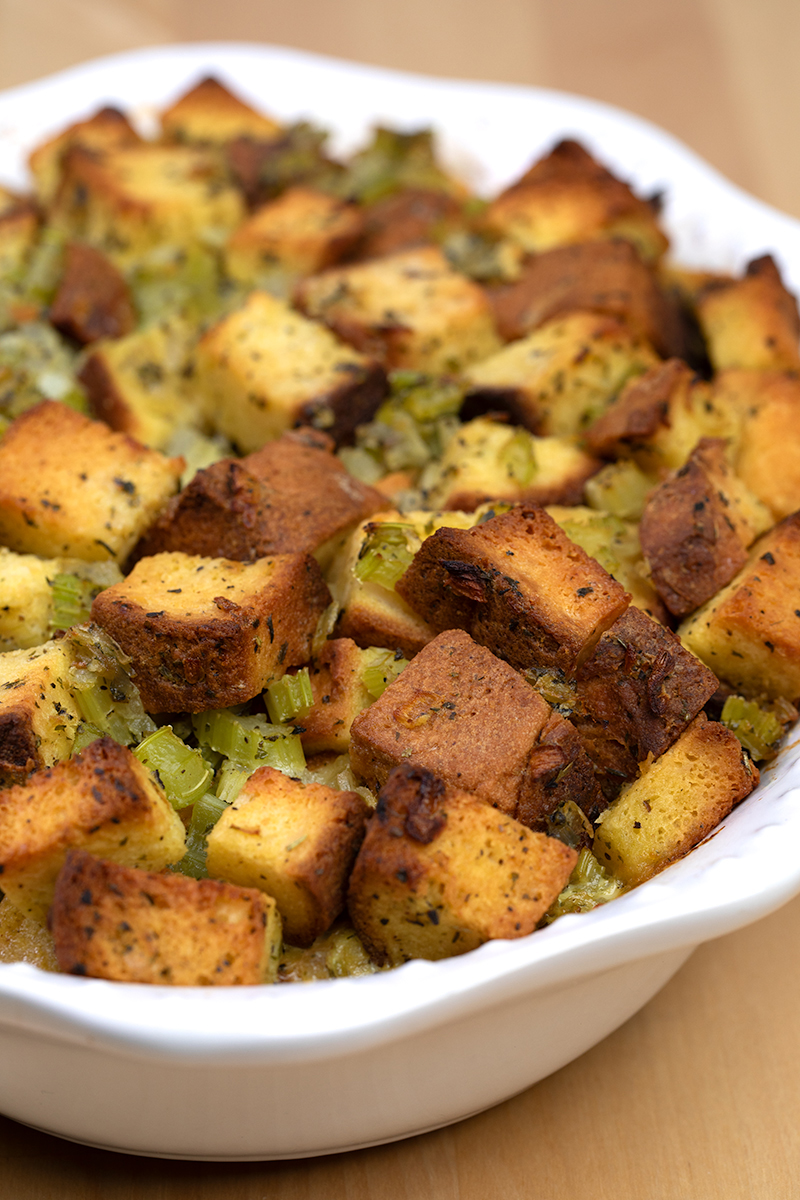
Preparing homemade stuffing might take longer than using a prepackaged mix from the store, but the end result is much healthier and worth the effort. Like with most Thanksgiving recipes, the flavors you'll experience are incomparable to anything you can buy off the shelf. But don't just take my word for it – let me show you how to make a delicious turkey dressing for your holiday table.
Why I love this recipe
- Tons of flavor: There aren't a lot of ingredients in this stuffing, but the herbs, spices, and aromatics are present in just the right amounts for maximum flavor.
- Super moist: Drying out the bread in the oven first then adding just enough chicken stock and beaten eggs, along with onions, celery, and spices makes for a super moist stuffing
- Can prep bread ahead of time: Making the gluten free bread for the stuffing is the most time-consuming part, and it can be done days, if not weeks, ahead of time.
- Even good as leftovers: This stuffing is one of the only dishes made with bread or breadcrumbs that I actually almost prefer as leftovers, even straight from the refrigerator!
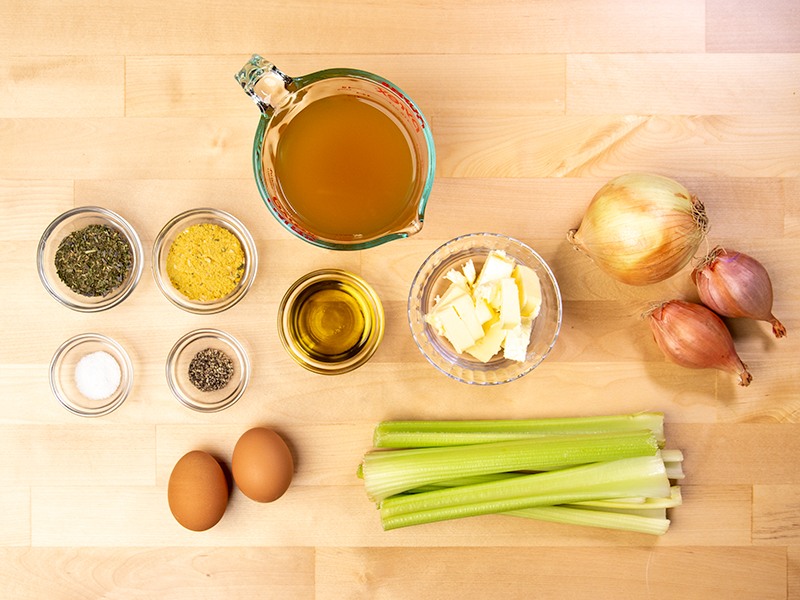
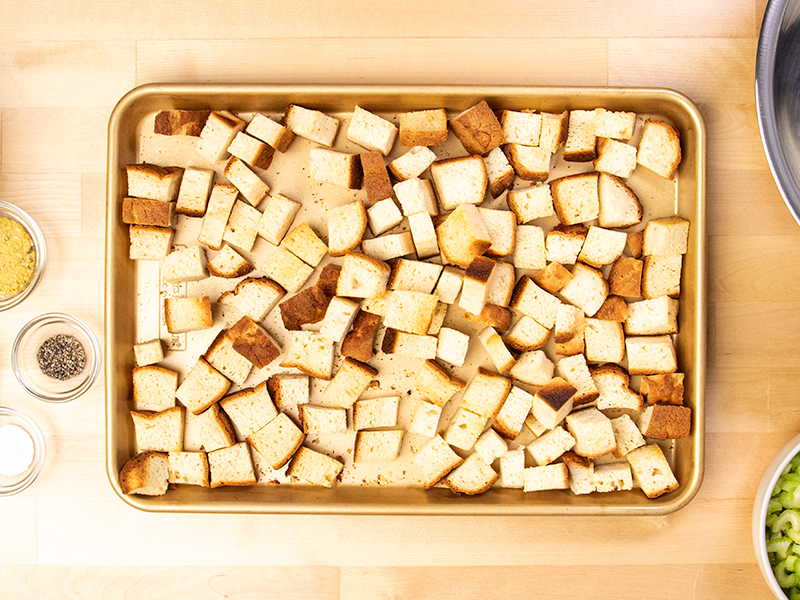
what's in it
Ingredient notes
- My gluten free Thanksgiving stuffing recipe is a healthy alternative to store-bought dressings, often containing preservatives, artificial flavorants, corn syrup, soy proteins, and more.
- Gluten free bread: You'll need a full 1 pound loaf of gluten free bread for this recipe. My classic white gluten free bread recipe works great, and I also like to use my recipe for gluten free Japanese milk bread here. You can also use store-bought gluten free bread like Canyon Bakehouse; just cut it into cubes as large as you can. Dry-toasting this moist, enriched bread prepares it to absorb the flavors of the cooked vegetables and stock without turning mushy. You aren't quite turning them into homemade gluten free croutons, but if you were to bake them longer, you would!
- Olive oil and butter: A combination of these two fats adds richness, flavor, and helps to deliver the flavors of the aromatics.
- Onions & celery: These are your aromatics, cooked down without browning so they retain lots of their unique flavor and aroma. I like a combination of white onions and shallots.
- Salt & pepper: Enhance, brighten and balance the flavors in the dish.
- Vegetable bouillon: A simple mix of nutritional yeast flakes, minced dried onion, garlic powder, dried parsley, and dried thyme adds so much flavor. If you don't have nutritional yeast, you can try replacing it with a bit of finely grated Parmesan cheese. You can also replace the homemade vegetable bouillon with 2 tablespoons or 2 cubes of packaged gluten free chicken or vegetable bouillon. Herb Ox and Edward & Son’s Not Chick’N brands are gluten free.
- Poultry seasoning or herbs de Provence: Spice blends that add that poultry flavor to your stuffing.
- Chicken stock: Moistens the bread and adds more flavor. You can use vegetable broth if you prefer.
- Eggs: Bind the dish together and also add some fat for richness.
Choosing the best gluten free bread for stuffing
The most essential ingredient in this gluten free stuffing mix is the gluten free bread. If you get the bread wrong, you may as well toss it away and start again. Gluten free bread will hold onto tons of flavor and will never leave your stuffing soggy. When prepared and toasted just right, it will make a stuffing that’s slightly crisp on some edges, but otherwise tender and soft; it’s never mushy or hard.
In the hunt for the perfect gluten free dressing for Thanksgiving, I’ve used every type of gluten free bread possible – from the squishiest to the most crusty. I’ve made it with lean breads and enriched breads. Cornbread, too.
After testing and comparing, my favorite gluten free bread for Thanksgiving stuffing is my gluten free Japanese milk bread. It’s slightly enriched with an egg, some butter, a water roux for moisture retention, and milk, so it’s soft and tender.
This milk bread is soft enough that, when I bake it in a low, 300°F oven for about 40 minutes, it dries out and toasts lightly—but doesn’t harden. Since our basic white gluten free bread is also enriched with eggs, milk, and butter, it performs similarly and you shouldn't hesitate to use it here.

How to make gluten free stuffing
This recipe is a game-changer for anyone seeking the ultimate gluten free Thanksgiving stuffing. It's so flavorful and satisfying that it stands out as a star dish on its own, full of flavor and different textures.
The full recipe card is below, but before you get started, I have a few important notes to share to ensure your stuffing comes out just right. Choosing a suitable gluten free bread for this recipe is vital, and the method you use to toast it and mix it with the other ingredients is also crucial for getting a good-textured stuffing.
Toast bread & cook aromatics
- Cutting your bread into cubes or tear it into rough pieces.
- Toast the bread until it's dry, but stop short of making it as crunchy as homemade gluten free croutons
- Cook down onions, celery, herbs and seasoning in melted butter and olive oil until tender.

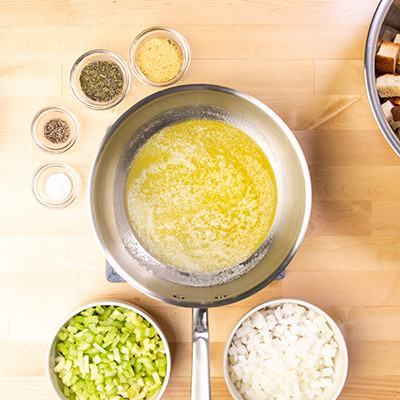
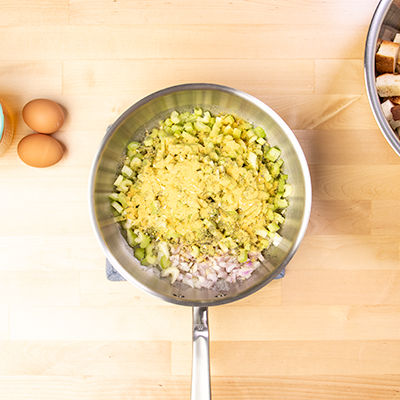
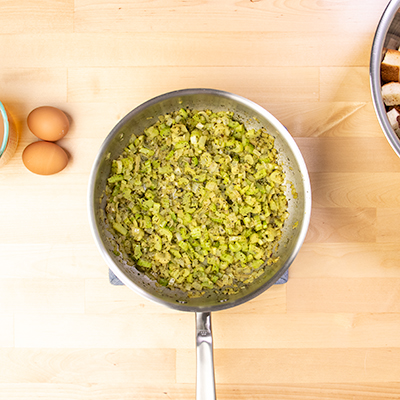
Combine all ingredients & transfer to baking dish
- In a large bowl, add two eggs and lots of flavorful chicken stock or vegetable stock to the aromatics and toasted bread to complete the dish.
- Transfer to a buttered casserole dish and spread evenly.
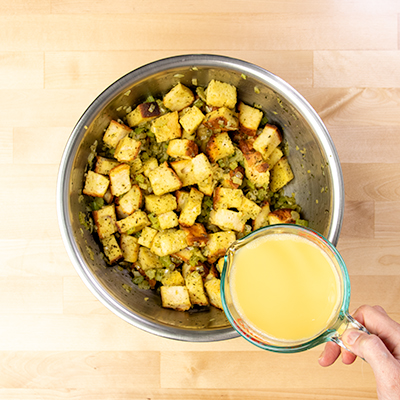
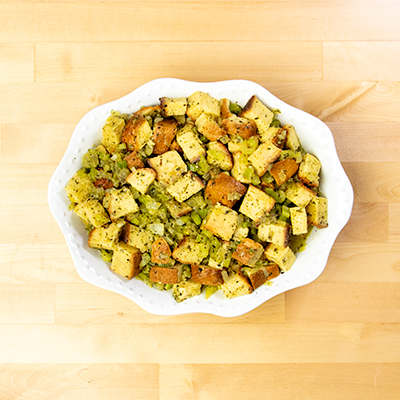
Bake at 350°F and serve
- Cover the dish first, so the eggs can set and the bread absorbs the liquids.
- Bake the completed dish at 350°F.
- Finish baking uncovered to perfection, so everything gets toasty and delicious. Serve warm!
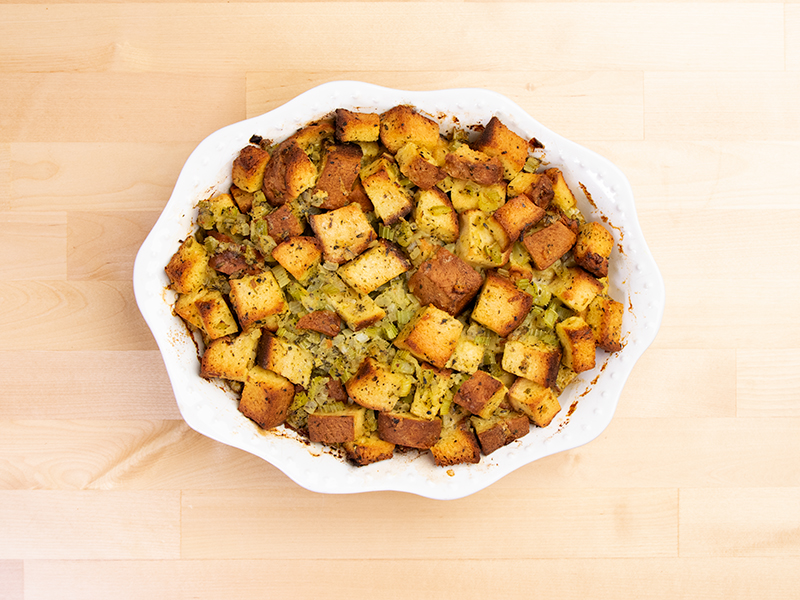

My Pro Tip
Recipe Tips & Tricks
Honestly, it's difficult to get this recipe wrong as long as you follow the instructions step by-step. You can play with flavor a little, adjusting the seasoning and the veggies you add, and not have to worry about it not turning out beautifully.
It's simple and versatile, but there are still a few tips to help make sure your stuffing is flawless:
Toast the bread low and slow
We’re using a loaf of bread that’s very soft inside with a thick, bakery-style crust outside. When we tear it into pieces, we expose that tender center, which we then dry out in the oven.
Toast the bread and dehydrate it in a low, 300°F oven—don’t bake it. It takes some time, but this is how we create just the right textured bread to absorb all the flavors we will add.
Check your bouillon and stock carefully
If you'd rather not make your own bouillon as the recipe states, you can use packaged gluten free bouillon. But you have to be careful when buying bouillon and stock as many brands contain gluten. Unless the packaging specifically says that it's gluten free, I would avoid it.
I've got a Homemade Vegetable Bouillon Powder here that you can make in advance and store for when you need it. I recommend making at least 3 times the amount specified, since I add it to all sorts of chicken and rice dishes.
I also strongly recommend choosing a high-quality stock that's rich and has good depth of flavor. Watery stock that doesn't have much flavor will lead to a much less flavorful dish. I really like Pacific chicken stock, but of course homemade chicken stock would be the absolute best!
Don’t skimp on the aromatics, herbs, and spices
Cook down chopped yellow onions and shallots, and a bunch of chopped celery with lots of herbs and spices. I like to use powdered vegetable bouillon, poultry seasoning (a blend of woodsy, earthy spices like sage, marjoram, and rosemary) or Herbs de provence (dried thyme, marjoram, savory, rosemary, lavender, & sage), and lots of good, dark chicken or vegetable stock.
I also really love this recipe with fresh or fresh-frozen herbs like sage and rosemary. You just can't beat the flavor of fresh herbs in this kind of dish, but remember that you'll need twice as much fresh as dried herbs.
Don't beat up your bread
When you mix the wet ingredients into the toasted bread chunks, don't be too forceful. Take it gently and steadily so you don't beat up the bread and cause it to break down too much.
Collect leftover pieces of the right gf bread all year
My children were never the type to refuse to eat the crusts, but sometimes there's an odd piece of Japanese milk bread or another appropriate gf bread that doesn't get eaten. l save and freeze all of those ends and slices of gluten free bread in a freezer-safe ziptop bag. Then, whenever I need gluten free breadcrumbs, stale bread for stuffing, or homemade gluten free croutons, I’ve got the bread for it ready to go.

substitutions
Ingredient substitution suggestions
You can switch up this simple recipe to accommodate pretty much any dietary need. Just remember you may also need to tweak the bread recipe or choose a different bread, depending on the substitutions you want to make.
Dairy free
To replace the dairy in this recipe, you’ll need to make a substitution for the butter, and leave out the cheese, which is optional anyway. In place of the butter in this recipe and in the bread recipe, try using vegan butter (Melt and Miyoko’s Kitchen brands are best). For milk in the bread, use your favorite unsweetened nondairy milk, but make sure it's not nonfat.
Egg free
There are only two eggs in this recipe, but they do a lot of work helping to hold the stuffing together. Without eggs, the ingredients easily separate from one another.
You can try using one “chia egg” instead of each egg in the recipe. I make a “chia egg” by combining one tablespoon ground white chia seeds with one tablespoon lukewarm water, and allowing it to sit until it gels.

Variations
Creative twists on traditional stuffing
As long as you have the right type of gluten free bread and the correct proportions of eggs and stock, you can vary the flavors quite a bit. Whether you like sweet, meaty, or spicy, you can tweak this simple recipe to make your own family favorite.
Here are some suggested variations for my gluten-free stuffing:
Cranberry and apple
When cooking the onions and celery, add two peeled, cored, and diced apples, and one cup of dried cranberries to the aromatics when you add the stock.
Sausage
Cook 1 1/2 cups of crumbled bulk sausage until it is no longer pink. Remove the cooked sausage and set it aside, leaving behind the grease.
Add 1 to 2 tablespoons of olive oil, and cook the aromatics, replacing the sliced onions with 1 cup of cleaned and sliced leeks.
Tex-Mex cornbread
Replace the Japanese Milk Bread cubes with cubed Gluten Free Cornbread. Add 1 diced jalapeño pepper, ribs and seeds removed, and 1 seeded red bell pepper to the aromatics. After you add the stock, add 1 cup of frozen corn kernels. You can find more details on how to use cornbread in place of bread in our gluten free cornbread stuffing Thanksgiving recipe.

make ahead/leftovers
Storage instructions
Leftover gluten free stuffing can be stored in an airtight container in the fridge to enjoy in the coming days. Zip-top bags work well here to stop the bread from losing its moisture. When ready, reheat the bread on low power in the microwave or oven.
If it's been more than a couple of days and if it's lost some moisture, try adding some gluten free gravy if you have any left from the big day. And serve it alongside leftover cranberry sauce, too!
You can also store extra stuffing in the freezer for up to three months. Again, make sure it's in an airtight container. Transfer it to the fridge to defrost the day before you want to eat it. I recommend sprinkling it with water and baking it from here to help bring back its texture.

Frequently asked questions
Most classic stuffing, the mixes you buy in bags or boxes at the store, are not gluten free. That's because they contain bread cubes that are made with wheat flour.
Even those labeled “cornbread stuffing” contain gluten unless otherwise labeled — cornbread is more of a flavor name than an ingredient.
While there's technically a difference between the two, whether you use the word stuffing or dressing to describe the mixture of bread cubes, vegetables, and stock accompanying many turkeys on Thanksgiving is more likely to come down to where you live.
In the South, most people call this concoction with the savory flavor “dressing.” Up north, it tends to go by “stuffing.” In many regions, you can use either word, and people will know exactly what you mean. However, for purists, stuffing is the mixture that's cooked inside the turkey, while dressing is cooked to go beside it.
No, Pepperidge Farms does not have gluten free stuffing. Even its cornbread variety contains gluten, and at this time, the brand doesn't make any gluten free options.
Despite being a staple around the holidays, traditional Stove Top stuffing is not gluten free — nor does the brand offer a gluten free stuffing among its many flavors.
Thankfully, you can make gluten free stuffing that tastes better than anything from a bag when you follow my easy recipe.
Yes! You can use your favorite packaged gluten free bread to make this stuffing. Just cut the slices into the largest pieces you can, and be sure to toast it until the bread is dry so it doesn't fall apart during baking.
If you routinely bake your own gluten free bread, definitely hold on to those ends and stale slices. Store them in the freezer until you have enough for a batch of gluten free turkey dressing, and your efforts will never go to waste.
Yes, you can use turkey drippings in place of some or all of the chicken broth or stock. The drippings will result in an even deeper, more intense flavor — just be sure to mix the drippings with water to thin them out to the right consistency.
If you replace all the dairy and the eggs, and you use vegetable stock instead of chicken stock—you have a recipe for gluten free vegan stuffing for your holiday table.
Food safety is of paramount importance whenever you’re working with raw meat. According to the Cleveland Clinic’s website, it’s safe to eat dressing cooked inside a raw bird if you take certain precautions. Don’t add the stuffing ingredients until right before cooking. And make sure to test the dressing itself with an instant read thermometer and cook it until it reaches at least 165°F.
Yes! You can make the recipe through to baking it for the first 30 minutes, covered with foil. Remove the stuffing from the oven, leave the foil on, and allow it to cool to room temperature.
After it’s come to cool room temperature (it will take some time), remove the foil. Cover your make ahead gluten free stuffing with freezer-safe wrap (Glad Press n Seal works particularly well) and freeze. The day before you intend to serve the dish, defrost it in the refrigerator overnight. Remove it from the refrigerator and finish baking it, uncovered, according to the remaining recipe instructions.
I get it: When you're hustling and bustling to get food on the Thanksgiving dinner table, you may not want to think about adding gluten free stuffing from scratch to your list. Here are some prepackaged gluten free options that are worth trying for your next holiday meal if you're really pressed for time:
– Aleia's Savory Stuffing Mix
– Gillian's Gluten Free Homestyle Stuffing Mix
– Trader Joe's Gluten Free Stuffing Mix
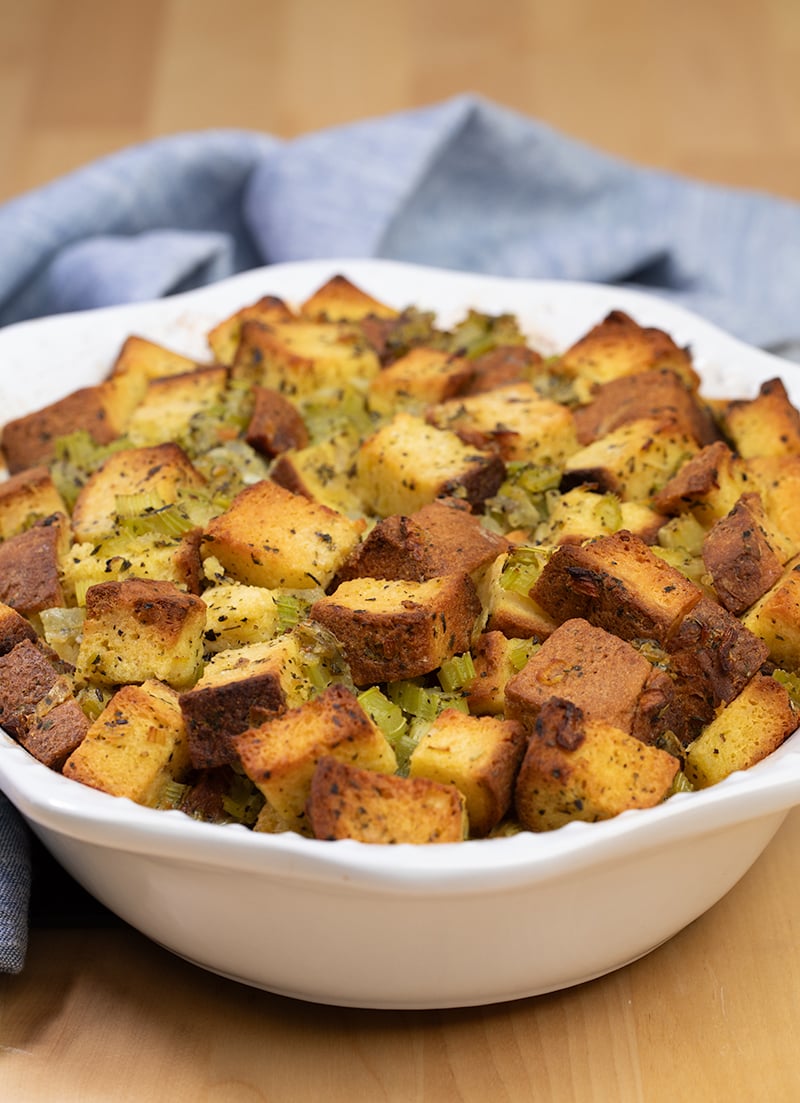
Gluten Free Stuffing Recipe
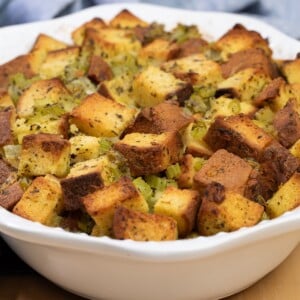
Ingredients
For the vegetable bouillon
- 1.5 tablespoons (8 g) nutritional yeast flakes, (See Recipe Notes)
- 1 teaspoon minced dried onion, can substitute 1/2 teaspoon onion powder
- ¼ teaspoon dried parsley
- ¼ teaspoon garlic powder
- ¼ teaspoon dried thyme
- ⅛ teaspoon dried turmeric, (optional)
For the stuffing
- 1 pound Gluten Free Japanese Milk Bread, See Recipe Notes
- 2 tablespoons (42 g) extra-virgin olive oil
- 6 tablespoons (84 g) unsalted butter, chopped
- 2 large yellow onions, peeled and diced (or a combination of onions and shallots)
- 2 cups chopped celery, from about 6 stalks celery
- 1 teaspoon kosher salt
- 1 teaspoon freshly ground black pepper
- 2 tablespoons vegetable bouillon, homemade vegetable bouillon powder or store-bought (See Recipe Notes)
- 2 tablespoons poultry seasoning, or herbs de Provence (See Recipe Notes)
- 2 (100 g (weighed out of shell)) eggs, at room temperature
- 1 ½ cups (12 fluid ounces) vegetable or chicken stock
- 1 ounce Parmigiano-Reggiano cheese, shredded (optional)
- 2 tablespoons unsalted butter, cubed for dotting on top of stuffing (optional)
Instructions
- Preheat your oven to 300°F. Grease well a 9-inch x 13-inch baking dish and set it aside.
- First, make the vegetable bouillon. In a small bowl, place the nutritional yeast flakes, minced dried onion, garlic powder, dried parsley, dried thyme, and optional turmeric, and whisk to combine. Set the bowl aside.
Toast the bread.
- Tear or slice the gluten free bread into roughly 1-inch pieces. Place them on a rimmed baking sheet.
- Place the baking sheet in the center of the 300°F oven, and bake for 30 to 40 minutes or until dried out and lightly browned.
- Continue to bake until the bread begins to shrink in size slightly and feels dry to the touch. It may take longer than 40 minutes depending on how moist the bread was at the start.
- Stir at least once halfway through baking, to ensure even baking. Remove from the oven and set aside to cool.
Cook the aromatics.
- In a medium-size, heavy-bottom saucepan, heat the butter and olive oil over medium heat until the butter is melted.
- Add the onion, celery, salt, pepper, vegetable bouillon, and poultry seasoning or herbs de Provence, and stir to combine.
- Reduce the heat to medium-low, cover and cook, stirring occasionally, until the onions and celery are fork-tender (about 10 minutes). The vegetables shouldn’t be mushy or even browned.
- Increase the oven temperature to 350°F.
Combine the stuffing ingredients and bake.
- Transfer the vegetable mixture to a large, heat-safe mixing bowl. Add the cooled toasted bread cubes, and mix to combine.
- Whisk together the eggs and stock until smooth. Add the egg mixture to the large mixing bowl, and toss carefully to coat.
- Add the optional shredded Parmigiano-Reggiano, and mix gently until just combined.
- Transfer the mixture carefully to the prepared 9-inch x 13-inch baking dish. Press it gently into an even layer.
- Scatter the final (optional) 2 tablespoons of cubed butter evenly across the top of the stuffing. Cover the baking dish securely with aluminum foil.
- Bake at 350°F for 30 minutes. Uncover, and continue to bake until the eggs are set and the stuffing is golden brown all over (about another 30 minutes).
- When it’s done, the stuffing will feel relatively firm when pressed gently with a finger in a thick portion. The top edges will be crisped but not dark. Serve warm.
Video
Notes
Nutrition
Nutrition information is automatically calculated, so should only be used as an approximation.
Embracing a gluten free Thanksgiving
Whether you're cooking for gluten-intolerant family members or just want to try something new, this gluten free stuffing recipe is one you won't want to miss among your Thanksgiving recipes.
If you’re just starting your gluten-free journey, I have hundreds of tried and tested gluten free recipes for you to enjoy. I also have a comprehensive guide to a gluten free diet, where I share some of the top benefits of embracing a gluten free lifestyle and some tips for navigating store-bought products.
Most of the main dishes for any big holiday, like turkey and ham, are naturally gluten free. So for us, it's all about the Thanksgiving recipes for side dishes!
In addition to this stuffing recipe, it wouldn't be the holidays for my family without a gluten free green bean casserole made with homemade gluten free cream of mushroom soup, and our favorite gluten free sweet potato casserole with the crumble topping. For dessert, gluten free pumpkin pie and gluten free apple pie are essential!


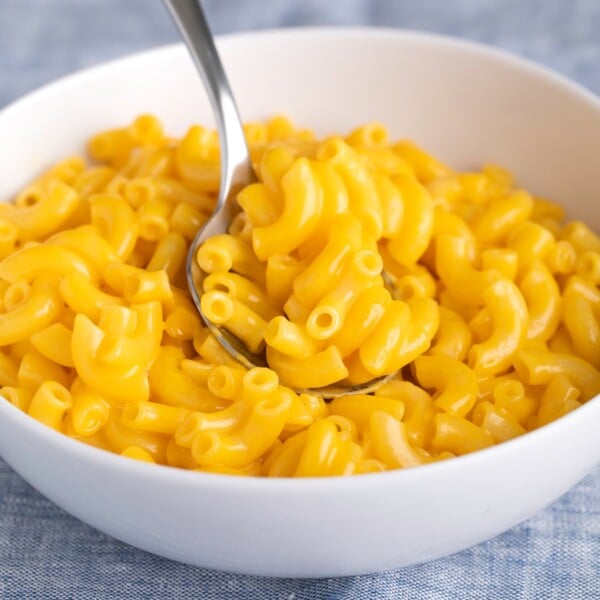
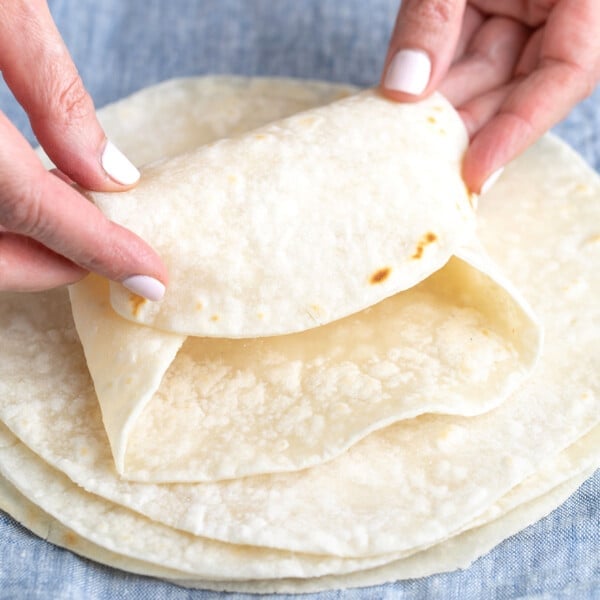
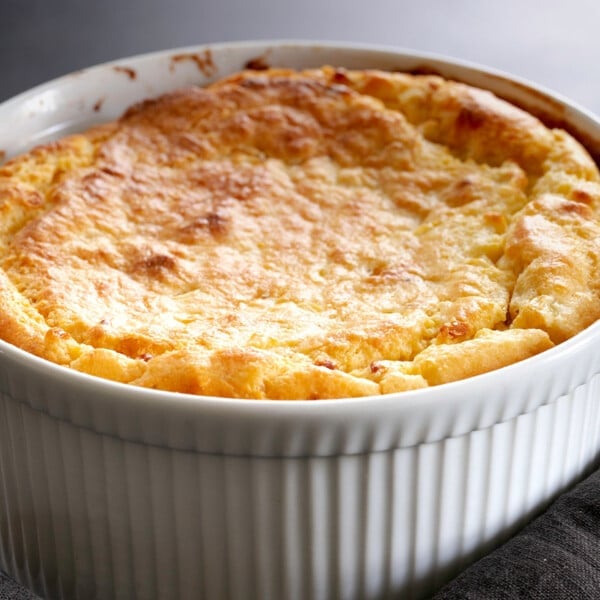
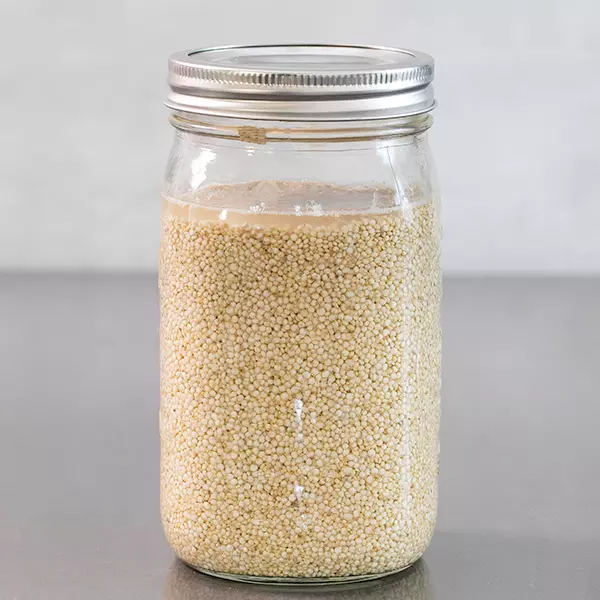









This was great and I didn’t even make the bread. I used Canyon Bakehouse Heritage store bought. I just made a GF stuffing and it needed a lot of help to make it ok. This recipe needed nothing. I’m so happy to have found it before Thanksgiving.
I’m so glad you gave this a try with the bread you had on hand, Kay. Happy Thanksgiving!
Nicole, Your dressing recipe is delicious! Definitely the best GF dressing we have ever had. Thank you so much – I have been missing a good, flavorful dressing for years! This is Thanksgiving week-end in Canada, & I know my family will love this :-)
I’m so glad you love it as much as I do, Marianne! It’s a simple recipe, but those are sometimes the hardest to get just right. Happy Thanksgiving to you and yours!!
Nicole, can the Japanese milk bread recipe be doubled successfully? I’m assuming this stuffing recipe can be easily doubled. This looks awesome! *comments were closed on the bread recipe page. Thank you!
Hi, Holly, Good question! I really don’t like doubling yeast bread, since things tend to go sideways, but you could definitely make two sets of dough in tandem. Just measure out the dry ingredients in two bowls, the wet ingredients separately, and mix each in the mixer one set after the other. And yes, the stuffing recipe can definitely be doubled!
Can this be prepared a day before and heated up? If so, which steps would you go through early and which would you reserve for the day of? I am not much of a cook, but I would love to have dressing on Thanksgiving this year at my family’s dinner.
Thanks!
My favorite stuffing is with cornbread, sauteed/carmelized plantains, leeks (or shallots), and chanterelle mushrooms. YUM!!!
Not to be a buzzkill, but could you also recommend a dairy-free bread? My small intestine thanks you. :)
I used Nom Nom Paleo’s spatchcocked bird recipe last year, and it was delicious. It also cooked much faster, which was a plus. I also feel very fancy using the word spatchcock. I plan to do it again this year (both use the recipe and use the word).
Donia, I was shocked to see your post because I assumed you already make the breads from the book using the dairy free suggestions Nicole provided in the book. I love Nom Nom Paleo! I don’t have to be dairy free, but I am a lot of the time.
I found that the extra water that the dairy-free versions required made them behave very differently than the dairy versions. They could not be kneaded, rolled, or handled the way the dairy versions could. There was a lot of sticking. Ultimately, I found it easier for me personally to keep using the old-school recipes, because they just go from mixing bowl to pan. I have the white sandwich bread recipe from the first book memorized, and make it about 3 times a week. As I’ve mentioned before on the blog, I’m sort of a lazy baker. I don’t like to make cookies because of all of the in and out of the oven, then cooling racks, etc. It’s probably a problem with me, not the dairy-free flour recipe. ;)
So that’s my dirty little secret. But I am happy for the successes of others with the dairy version of the bread flour! If I could tolerate more dairy, I’d be right there with you!!
I knew Donia’s dirty little secret already! My husband feels the same way about the old bread recipes, he makes the brown bread (we call it teff bread in our house) from the blog several times a week. He is all about easy! And I must investigate this spatchcock word! Really rolls off the tongue, doesn’t it!
Soak your turkey in a salt/sugar brine for 2-3 days before you bake it. I promise you won’t be sorry!
Oh I have yet to try the Japanese Milk Bread. I guess I must do so and make a couple extra loaves for T-Day! I make my own turkey stock beforehand from parts I buy in supermarket. I have to blend the onion and celery in the stock because my daughter likes the flavor but not to chew the actual onion or celery. Only way she chews an onion is if it is a onion ring or crispy fried onions. We use GF Jones sausage in our stuffing. I do cook it in the bird and I also make extra to cook outside the bird.
Lovely stuffing Nicole, we hardly ever roast turkey… It’s always ham, beef or chicken.
We always make stuffing and I’ve had some failures, I’ll try this recipe next and make sure I have the Japanese Milk Bread on hand :)
The Lemon Meringue Pie was a hit, thanks for the pie crust recipe!
We ended up using rotini pasta for the lasagna dish and it was excellent too!
How many cups of bread cubes? I’m not sure I’ll have time to bake the bread and will probably have to buy it pre-made.
It’s about 9 to 10 cups, Lynda.
Thank you!